Roll-Off Container Truck Driver Electrocuted When Raised Tilt Frame Contacted Overhead Line
Michigan Case Report: 08MI005
Summary
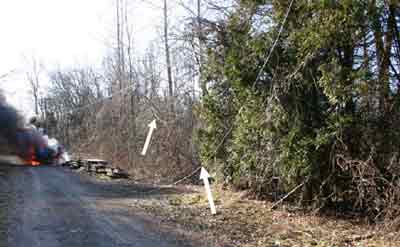
|
|
Figure 1. Burning roll-off truck/trailer, melted power lines on ground and in trees |
On January 18, 2008, a 45-year-old male truck driver for a roll-off container company was electrocuted when the tilt frame he had raised to load a full 40-cubic-yard roll-off container contacted energized 7,600-volt overhead power lines. He had deposited the empty 8-foot-high x 8-foot-wide x 22-foot-long roll-off container at the customer’s property several days earlier. The decedent was dispatched to remove the full container from the property. He stood on the frozen ground holding the trailer’s tilt frame lift controls in position to raise the tilt frame to load the full container onto the trailer. The controls were located near the front of the driver’s side of the trailer. The tilt frame can extend to a height of approximately 31 feet above the ground. The overhead lines contacted were 29 feet 3 inches above the ground. When the tilt frame contacted the overhead wires, electrical current moved through the decedent’s body from his left hand to ground through his left foot. The property owner was leveling scrap in the container while the decedent was raising the tilt frame. The property owner noticed a small brush fire at the end of the trailer. He jumped from the container and upon contact with the ground he felt a “tingle.” He investigated further and saw that all the trailer tires were smoking. As he looked towards the driver’s side cab of the truck he could see the decedent lying on the ground. Because of the fire, he moved the decedent away from the truck into a nearby wooded area and called 911. Emergency response arrived, and the decedent was declared dead at the scene.
Recommendations:
- The employer should affix a dry non-conductive material using non-conductive insulators and fasteners at the very top of the tilt frame as a redundant safeguard prior to raising the tilt frame to prevent direct contact with an overhead line.
- Employers should stress hazard awareness regarding overhead power lines and routinely review the issue so that all employees are cognizant of these energized sources.
- Employers should train employees who work alone to conduct a jobsite survey (hazard assessment) to identify potential hazards before starting any job and to implement appropriate control measures.
- Equipment manufacturers should investigate the possibility of a retrofit of operating controls for boomed vehicles when designed for use from ground level to insulate the operator from the vehicle.
- Employers should develop, implement, and enforce a comprehensive written safety program, and should include:
- a safety statement that management is committed to providing leadership to ensure a safe and healthful workplace,
- a safety policy that states “a driver will not place or position or pick up a roll-off container under a power line,” and
- the development of a health and safety (H&S) committee.
- Employers should ensure that a responsible person such as a supervisor/manager periodically monitors workers who are assigned to remote locations.
- Employers with roll-off trailers as part of their fleet should:
- measure the raised tilt frame height of each of their trailers and post this height prominently in either the cab compartment and/or on the trailer near the operating levers, and
- inspect the trailers to ensure affixed signs warning of contact with overhead power lines are present and legible on a routine basis.
Introduction
On January 18, 2008, a 45-year-old male truck driver was electrocuted when the raised trailer tilt frame contacted a 7,600-volt overhead power line. On the same day as the incident, the Michigan Occupational Safety and Health Administration (MIOSHA) personnel, who had received a report on their 24-hour-a-day hotline, informed MIFACE investigators of this work-related fatality. On January 24, 2008, MIFACE interviewed the company’s equipment manager and the company’s general manager at the company headquarters. The company’s general manager accompanied the MIFACE researcher to the container storage yard. The company manager permitted the MIFACE researcher to take pictures of a sample roll-off container and during the unloading of a roll-off container from a trailer. During the course of writing this report, the police report and pictures, death certificate, medical examiner report, and the MIOSHA file and citations were reviewed. Pictures used in Figures 1, 2, 5, 6, and 7 of this report are courtesy of the responding police department and pictures used in Figure 3, 4, 8, and 9 were taken at the time of the MIFACE site visit.
The company for whom the decedent worked was a trucking firm. The firm had 30 employees, 24 of whom were roll-off container truck drivers. The company had been in business for approximately seven years. The decedent worked full time. The normal work shift was 10 hours. The work shift began at 6:00 a.m. and concluded at 5:00 p.m. including lunch and breaks. The decedent had at least 10 years of experience of driving roll-off trucks. The decedent had worked for other roll-off companies prior to his current employment. His present company had employed him approximately one and one-half years.
The company did not have a written health and safety program, written procedures for the task being performed by the decedent, nor a health and safety committee. Safety issues were discussed daily, especially when the drivers would return to the company headquarters. The company owner greeted drivers returning to headquarters and talked with them about the day’s occurrences and general safety issues. The company owner indicated he gave them daily reminders, such as “slow down,” and “buckle up.” The firm did not maintain written documentation of these daily talks.
The company did not have a written policy regarding working near overhead power lines nor formal training about the hazards of power lines. The employees were expected to use common sense, “be careful”, “don’t operate under power lines”, and “look up first before raising boom – don’t contact power lines.”
The decedent’s employer had an individual designated as a trainer to test the skills of new hires and to ensure that they received the verbalized safety instructions. The company owner indicated that the firm tended to hire knowledgeable people for the roll-off operation so formalized training was not usually given. All hired drivers, including the decedent, drove with another driver for at least a day for training purposes. This training included: (a) if location of the power line creates a danger, call dispatch and tell them its too dangerous to load/unload trailers, (b) always look up and make sure it is clear, (c) drag container out from under power lines, and (d) power lines can arc.
The firm for whom the equipment manager worked dispatched all roll-off company drivers to drop-off or pick-up the roll-off containers. The dispatch company traveled to the drop-off/pick-up site to respond to any driver’s complaints or issues with container placement. Neither the dispatch company nor the decedent’s employer performed site checks to ensure the drivers were adhering to the verbalized training instructions.
The decedent was wearing safety glasses, a hard hat, and what appeared to be rubber-coated work gloves at the time of the incident.
At the conclusion of its investigation, MIOSHA General Industry Safety and Health Division issued the following Serious citations citing General Industry Safety Standard, Part 40, Electrical Safety-Related Work Practices:
- RULE 4005(5):
- Insure that an unqualified person working on the ground in the vicinity of overhead lines does not bring any conductive object closer to unguarded energized overhead lines than 10 feet up to 50kV plus an additional 4 inches for every 10kV over 50kV.
- RULE 4002(2):
- Insure that exposed employees are trained in and familiar with the safety-related work practices that pertain to their respective job assignments as specified in Rule 4002(3) to 4002(7). (Employees working on the ground bringing conductive objects such as metal containers and tilt frame in the vicinity of overhead power lines did not know required safety distances.)
Investigation
The decedent had been dispatched two days prior to the incident day to drop off an 8-foot-high x 8-foot- wide x 22-foot-long roll-off container (Figure 2) at a customer’s property. The decedent had placed the container under the power lines, which were 29 feet 3 inches above the ground at the incident location. It is unknown if the decedent used a different tractor/trailer combination at the time of container unloading. The electric utility company measured the height of the overhead lines after the incident.
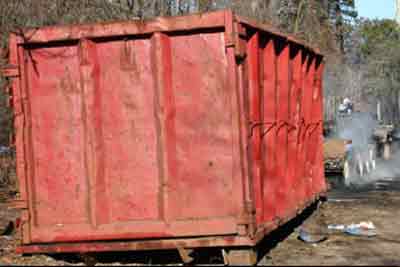 |
|
Figure 2. Container involved in incident |
The property owner was in the process of having scrap metal removed from his property. On the day of the incident, the decedent was dispatched to drop off another empty container and pick up the existing container, which the customer had filled with scrap. He drove a 2000 Kenworth tractor/1999 BENLEE roll-off trailer to the site. The 6-axle roll-off trailer had an overall length of 43 feet with a tilt frame length of 41 feet. The tilt frame extended up from the ground approximately 31-1/2 feet. A warning sticker was placed on each trailer warning of a potential electrocution hazard.
The decedent dropped off the empty container he was delivering in the middle of the driveway. He spoke with the property owner and instructed him to level the scrap in the full container because it was too high. The property owner entered the container and was in the process of leveling the load while the decedent was preparing to pick up the container.
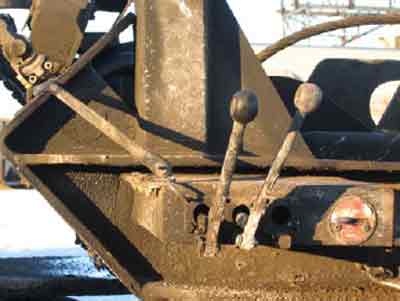 |
|
Figure 3. Example of trailer-mounted control levers used to raise/lower tilt frame |
MIFACE observed the unloading of a roll-off container into the storage yard. The company general manager described the loading process as the reverse of the unloading process. The trailer’s tilt frame must be raised using one of the two trailer mounted control levers (Figure 3). One lever activated the hydraulic cylinders to raise the tilt frame and the second lever controlled the four-part cable that attached to the container to be loaded onto the trailer. Both levers returned to neutral when released. The company general manager indicated that all tilt frame control levers had a rubber coating on the ball of the lever. To load the roll-off container, the tilt frame must be raised until the tail section of the tilt frame touched the ground (Figure 4). The 4-part cable, which had a ring on the end, would be wrapped over a hook on the front of the roll-off container. The operator activated the second lever to extend two reeving cylinders to pull the cable and the roll-off container up the tilt frame until the container was off of the ground. As the container was pulled up the tilt frame, the container wheels straddled the frame. Once the container was completely on the tilt frame, the second lever continued to be activated so the roll-off container was pulled the length of the tilt frame to the end stop while lever one was activated to lower the tilt frame to the trailer bed. After the container was at the end stop and the tilt frame was fully lowered, the container was secured.
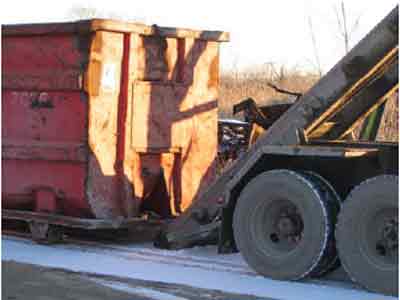
|
|
Figure 4. Example of container unloading and tilt frame touching the ground
|
At the incident site, as the decedent was lifting the tilt frame, the top portion of the upper rail at the right side/end stop area of the tilt frame contacted the two overhead primary 7,600-volt power line phases and the neutral wire (Figure 5). The property owner observed brush fires and hopped out of the container. Upon contact with the ground, the property owner felt a “tingle” as he went around the trailer. The property owner noted the tilt frame in the up position making contact with the wires. He noticed more burning and saw the decedent on the ground near the controls on the trailer. The point of entry of the electrical current was at the little finger of his left hand (Figure 6) and exited at bottom of his left foot. He could not get a response from the decedent when he spoke to him. The property owner was able to pull the decedent away from the tractor/trailer to safety, pulling him into a wooded area approximately 50 feet from the trailer. He attempted to revive him and was unable to get a response. The property owner then called 911 for assistance. Approximately 10 minutes later, the fire department arrived.
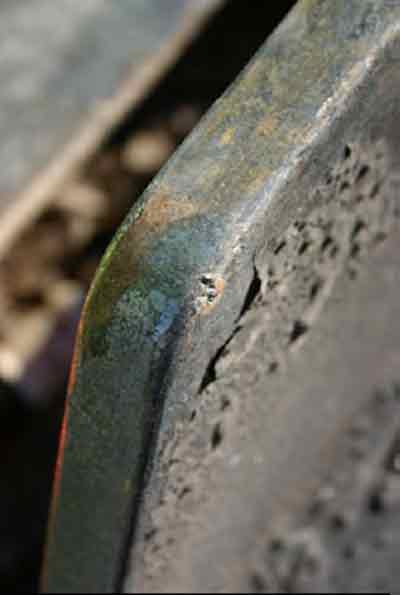
|
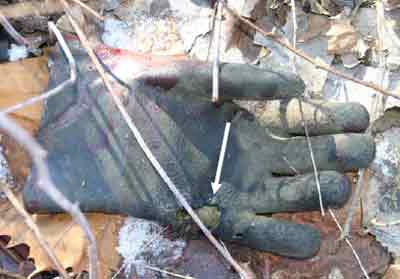
|
|
Figure 6. Work glove worn on decedent’s left hand, burn mark evident
|
When the fire department arrived, the tractor and trailer was partially engulfed in flames. The fire department contacted the local electric power company to come and shut off the power. The fire department did not initiate fire suppression efforts because of the active electrical lines. The fire department began resuscitation efforts, but due to the increasing fire hazard as well as decedent’s condition, resuscitation efforts were halted. As the fire intensified it caused the power lines to melt and fall to the container, vehicle and ground (Figure 7). The fire also caused failure of the trailer’s hydraulic boom causing it to lower, and the tilt frame to come down. The power company arrived and cut off power to the lines and the fire department put out the fires.
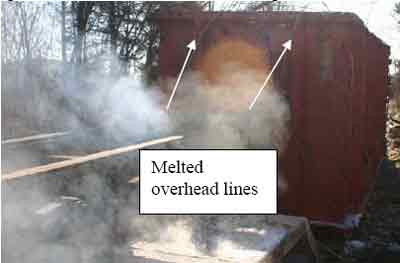
|
|
Figure 7. Melted overhead lines lying on container
|
Back to Top
Cause of Death
The cause of death as listed on the death certificate was electrocution. The toxicology report was negative for alcohol and screened drugs.
Back to Top
Recommendations/Discussion
The employer should affix a dry non-conductive material using non-conductive insulators and fasteners at the very top of the tilt frame as a redundant safeguard prior to raising the tilt frame to prevent direct contact with an overhead line.
While every effort should be made not to work under or in proximity to overhead power lines, a relatively easy and inexpensive redundant engineering control to prevent inadvertent direct contact of a raised tilt bed/roll-off container with an overhead line would be to install non-conductive materials at the very top of the tilt frame. These materials must be affixed using non-conductive fasteners. Materials such as fiberglass, insulating rubber, nylon, polycarbonate, and Teflon are examples of non-conductive materials and fasteners.

|
|
Drawing 1. Example of placement of nonconductive material on tilt bed.
|
Employers should stress hazard awareness regarding overhead power lines and routinely review the issue so that all employees are cognizant of these energized sources.
The danger of overhead power lines appears to be obvious; however, contact with overhead power lines and the subsequent occupational-related fatalities continue. Employers must stress and routinely review with employees the hazards associated with overhead power lines. Companies who have employees who work in the vicinity of overhead power lines should ensure that employees understand the hazards presented by overhead lines and the minimum distances that must be maintained between the equipment and the power line.
Employee training should include MIOSHA General Industry Safety Standard, Part 40, Electrical Safety-Related Work Practices. Rule 4005(5) of Part 40 requires that an unqualified person working on the ground in the vicinity of overhead lines not bring any conductive object closer to unguarded energized overhead lines than 10 feet up to 50kV plus an additional 4 inches for every 10kV over 50kV.
When new company procedures or guidelines are developed or existing ones modified, employers should ensure that workers are provided with appropriate supplemental training.
Although not directly applicable, information useful for training in work to be performed in proximity to power lines can be found on the world-wide web at: https://www.cdc.gov/niosh/crane.html, or by calling 1-800-356-4674 and requesting the NIOSH Alert: Preventing Electrocutions of Crane Operators and Crew Members Working Near Overhead Power Lines, NIOSH Publication No. 95-108. The Alert contains case reports and summarizes safety precautions for operators of boomed vehicles and cranes and ground crews. In addition, posting the single-page sheet found at https://www.cdc.gov/niosh/docs/95-108/pdfs/95-108sum.pdf at the work site or including in toolbox talks may serve as an additional means of communicating safe work procedures to workerspdf icon. (Link updated 4/9/2015)
Federal OSHA also has valuable resources that may assist employers and employees. One resource is the OSHA Construction e-tool for Electrical Incidentsexternal icon: https://www.osha.gov/SLTC/etools/construction/electrical_incidents/powerlines.html. Another OSHA resource is a pocket-guide that employers may provide employees: https://www.osha.gov/Region7/overheadpowerlines/ohpl_card_eng.pdf. (Link no longer available 4/9/2015)
Employers should train employees who work alone to conduct a jobsite survey (hazard assessment) to identify potential hazards before starting any job and to implement appropriate control measures.
Employers should train employees to conduct jobsite surveys to identify potential hazards so that appropriate preventive measures to control these hazards can be identified and implemented. Two characteristics of this jobsite combined to produce a serious hazard; 1) a 7,600-volt energized overhead power line located approximately 29 feet off the ground and 2) the use of a conductive trailer-mounted tilt frame in the vicinity of the power line. Such potential hazards can be minimized by ensuring that employees maintain a safe distance from energized conductors, by providing employees with non-conductive tools and materials, and/or by de-energizing or covering electrical conductors with insulating material. In this case, the decedent was either unaware of the overhead line location, or misjudged the height of the raised tilt frame in relation to the overhead line when he placed the trailer into position to load the container. A safety checklist should be developed as part of a standard operating procedure to conduct the jobsite analysis. This should be used prior to the start of any activity at the worksite.
The location of the machine (directly below the power line) and the proximity of vegetation may have interfered with the operator’s perception of distance to the power line. In addition, the decedent had successfully unloaded the empty container a few days prior to the incident, which may have affected his judgment in placing the tractor/trailer combination. If a jobsite survey and hazard analysis had been performed at the time of container delivery, the container most likely would not have been placed at its current position and the potential of electrical hazard posed by the overhead lines would have been controlled.
Equipment manufacturers should investigate the possibility of a retrofit of operating controls for boomed vehicles, when designed for use from ground level to insulate the operator from the vehicle.
Regulations concerning boomed machinery and overhead power lines provide operator protection when followed; however boomed equipment, when operated from ground level should have electrically insulated operating controls. The roll-off trailer was used in areas both with and without an overhead electrical hazard. The company should contact the manufacturer of the roll-off trailer to determine if the control levers could have an insulating material placed on them. The company should also require and provide each truck driver insulating gloves, and rubber boots or overshoes to be worn when working within the vicinity of electrical power lines to provide additional operator protection. MIOSHA General Industry Safety Standard, Part 33, Personal Protective Equipment, Rule 3387, Rubber protective equipment; certification; use and storage, details the requirements for insulating equipment, such as gloves, matting, blankets, covers, line hose and sleeves.
Employers should develop, implement, and enforce a comprehensive written safety program, and should include:
- a safety statement that management is committed to providing leadership to ensure a safe and healthful workplace,
- a safety policy that states “a driver will not place or position or pick up a roll-off container under a power line,” and
- the development of a health and safety (H&S) committee.
Safety starts at the top of an organization. Organizational commitment, management commitment and leadership, and employee motivation and buy-in are necessary to make a safety program effective. The safety culture of an organization can have a profound effect upon employees’ willingness to adopt and adhere to safe work practices and the company’s safety program requirements. A good safety culture may have fostered the replacement of the worn signs.
The firm’s health and safety program should include a mandatory policy of prohibiting the placement/pick-up of a roll-off container under an overhead power line. The driver and/or the employer should communicate this policy to all clients so that the client does not interfere with this policy. Although this may place a driver at odds with a client who may not adhere to this policy, the safety of the driver is paramount and other arrangements must be made to move the container into a safe position for loading.
Employers should evaluate tasks performed by workers, identify all potential hazards, and then develop, implement, and enforce a safety program that meets or exceeds applicable MIOSHA standards and best industry practices addressing these identified hazards.
The U.S. Department of Labor, Mine Safety and Health Administration (MSHA) Accident Prevention Miner’s Tip “Roll-Off Container Safetyexternal icon” contains several basic safety tips for roll-off container truck drivers to follow to prevent injury and property damage. These safety tips can be accessed via the Internet at http://www.msha.gov/accident_prevention/Tips/rolloff.asp
The development of a health and safety (H&S) committee would encourage and heighten employee involvement in the company safety program. The company manager and equipment manager present at the MIFACE interview indicated that employees are empowered to take care of safety hazards in the field. Only if the employees cannot rectify the hazards do they notify management.
Employee input is a critical part of a successful safety program; management would become more aware of potential recurring safety hazards in the field and employees can participate in developing safe work procedures.
Employers should ensure that a responsible person such as a supervisor/manager periodically monitors workers who are assigned to remote locations.
A person is considered alone at work when they are on their own, when they cannot be seen or heard by another person, and when they cannot expect a visit from another worker or member of the public for some time. The company’s roll-off drivers met this definition.
An employer should be confident that the employee working alone in a remote location will work in a safe manner and be able to follow all company procedures. Employers should determine the most effective way of supervising an employee who works alone. Direct or indirect supervision methods should be established to monitor a worker’s adherence to safe work practices and to the company’s health and safety procedures.
The Canadian Centre for Occupational Health and Safety (CCOHS) has developed guidance for employers who have employees who work aloneexternal icon: http://www.ccohs.ca/oshanswers/hsprograms/workingalone.html. Another source of information for developing a working alone policy is the Worksafe Western Australia Commissionpdf iconexternal icon: http://www.commerce.wa.gov.au/sites/default/files/atoms/files/working_alone.pdf (Link updated 4/9/2015)
Employers with roll-off trailers as part of their fleet should:
- measure the raised tilt frame height of each of their trailers and post this height prominently in either the cab compartment and/or on the trailer near the operating levers, and
- inspect the trailers to ensure affixed signs warning of contact with overhead power lines are present and legible on a routine basis.
MIFACE encourages all employers, companies and individuals who own and/or lease roll-off trailers measure the raised tilt frame height of each of their trailers at full tilt frame extension and post this height prominently in the cab compartment and/or on the trailer near the operating levels.
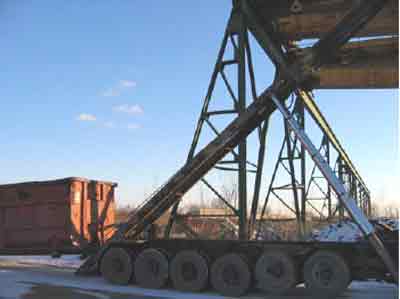
|
|
Figure 8. Example of full extension of tilt frame
|
The roll-off trailer fleet had tilt frames of different lengths, thus capable of different raised heights at full extension (Figure 9). Alerting a driver to the height of a fully raised tilt frame would provide him/her with an additional piece of information to determine if the container loading/unloading process could be safely initiated. The posting could be in the form of a safety sticker or indicated on the electrical hazard warning sign. The safety sticker could be developed in-house and contain the information shown in the example below:
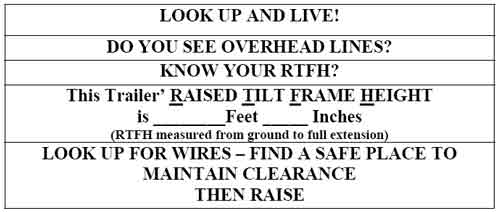 |
The company manager stated that all roll-off trailers come with electrical hazard warning stickers. As the trailers are repainted, the company replaces these stickers. Although the trailer shown in Figure 4 had the sticker warning the operator against contact with overhead power lines, it was very worn and faded (Figure 9). The company should establish an inspection schedule for the roll-off trailers to ensure the affixed warning stickers are present and legible, and not wait until the trailer is in need of paint. Employees are more likely to be reminded about overhead lines and the electrocution hazard the lines present if they see a bright, legible sticker versus a faded one as they operate the lever controls.
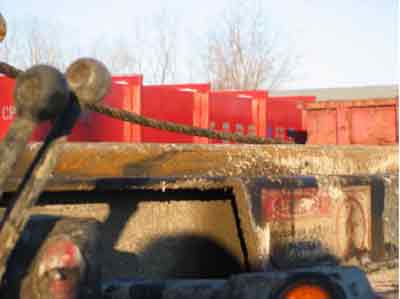
|
|
Figure 9. Operator view of faded and worn safety warning sticker on Figure 4 trailer
|
References
MIOSHA standardsexternal icon cited in this report may be found at and downloaded from the MIOSHA, Michigan Department of Labor and Economic Growth (DLEG) website at: www.michigan.gov/mioshastandards. MIOSHA standards are available for a fee by writing to: Michigan Department of Labor and Economic Growth, MIOSHA Standards Section, P.O. Box 30643, Lansing, Michigan 48909-8143 or calling (517) 322-1845.
- MIOSHA General Industry Safety Standard, Part 40, Electrical Safety-Related Work Practices.
- MIOSHA General Industry Safety Standard, Part 33, Personal Protective Equipment.
- Canadian Centre for Occupational Health and Safety (CCOHS) external iconhttp://www.ccohs.ca/oshanswers/hsprograms/workingalone.html
- Worksafe Western Australia Commissionpdf iconexternal icon http://www.commerce.wa.gov.au/sites/default/files/atoms/files/working_alone.pdf (Link updated 4/9/2015)
- Hispanic Laborer Electrocuted After Boom Truck Contacts Overhead Power Line – North Carolina. NIOSH In-house FACE Report 2005-02, June 10, 2005. https://www.cdc.gov/niosh/face/In-house/full200502.html
- Two Well Drillers Electrocuted when Their Truck-Mounted Boom Contacts Overhead Power Lines in California California FACE Investigation 96CA006 October 21, 1996. https://www.cdc.gov/niosh/face/stateface/ca/96ca006.html
- Inside Wireman Electrician Electrocuted Working on Exterior Light Polepdf iconexternal icon. MIFACE INVESTIGATION: #02MI119. http://www.oem.msu.edu/MiFace/02MI119v1.pdf
- Guardrail Post Pounder Operator Electrocuted When Hammer Boom Contacts Energized Overhead Electrical Line. pdf iconexternal iconMIFACE INVESTIGATION: #02MI152 http://www.oem.msu.edu/MiFace/02MI152v1.pdf
- Truck Driver Electrocuted When Raised Long-Bed Dump Trailer Contacted 4,800-Volt Overhead Power Line. pdf iconexternal iconMIFACE INVESTIGATION #06MI185. http://www.oem.msu.edu/MiFace/06MI185.pdf
- Drill Operator Electrocuted After Contacting A 7,200 Volt Overhead Power Line While Raising A Drill Rig Boom. New Jersey FACE Investigation #93NJ089. https://www.cdc.gov/niosh/face/stateface/nj/93nj089.html
- U.S. Department of Labor, Mine Safety and Health Administration (MSHA) Accident Prevention Miner’s Tip “Roll-Off Container Safetyexternal icon” http://www.msha.gov/accident_prevention/Tips/rolloff.asp
Michigan FACE Program
MIFACE (Michigan Fatality Assessment and Control Evaluation), Michigan State University (MSU) Occupational & Environmental Medicineexternal icon, 117 West Fee Hall, East Lansing, Michigan 48824-1315; http://www.oem.msu.edu/MiFACE_Program.aspx. This information is for educational purposes only. This MIFACE report becomes public property upon publication and may be printed verbatim with credit to MSU. Reprinting cannot be used to endorse or advertise a commercial product or company. All rights reserved. MSU is an affirmative-action, equal opportunity employer. 1/13/09 (Link updated 8/5/2009)
MIFACE Investigation Report # 08MI005 Evaluationpdf iconexternal icon (see page 13 of report)
